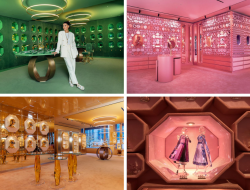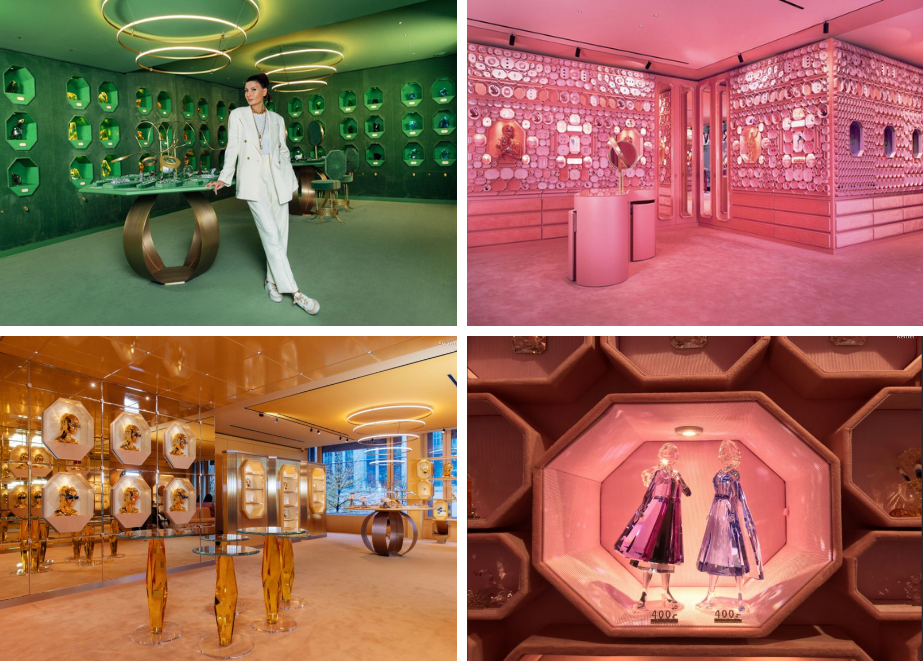The Sparkle of Swarovski Marketing Mix Success – Swarovski is an Austrian crystal manufacturer founded by Daniel Swarovski in 1895. The company is known for its precision-cut crystals, which are used in a variety of products, including jewelry, fashion accessories, home decor, and lighting. In this article, we study Swarovski’s marketing strategy and marketing mix.
The Sparkle of Swarovski Marketing Mix Success

swarovskijewelry – Daniel Swarovski was born in 1862 in the Bohemia region of Austria-Hungary (now the Czech Republic). His father was a glass cutter and Swarovski studied under him as a child. In 1892, Swarovski patented an electric cutting machine that could cut crystals more precisely than traditional methods.
With this new technology, Swarovski is able to produce crystals that are brighter and sparkling than before. The company quickly gained a reputation for its high-quality crystals and soon began supplying crystals to other jewelry manufacturers.
In 1915, Swarovski opened its first store in Vienna. The deal was an immediate success and helped establish Swarovski as a leading brand in the crystal industry.
Today, Swarovski is a global company with more than 29,000 employees, selling in more than 170 countries. The company’s products are sold in several different channels, such as retail stores, department stores, and the Internet.
Swarovski is known for its innovative designs and commitment to quality. The company’s crystals are used in a variety of products, including jewelry, fashion accessories, home decor, and lighting.
Swarovski is also a major sponsor of arts and culture. The company has donated millions of dollars to various charities and also commissioned artwork from some of the world’s most prominent artists.
Swarovski crystals are also used in many other industries such as architecture, lighting, and jewelry. The company’s crystals are renowned for their luster and luster and can be found in some of the world’s most iconic buildings and works of art.
Swarovski has a good opportunity to continue its growth in the future. The company has a strong brand, diverse products, and global presence. Swarovski is also committed to innovation, and the company is constantly looking for new ways to use its crystals in new and creative ways.
Swarovski’s founding story
Swarovski has a fascinating founding story that can be traced back to the innovative vision of its founder. Let us explore Swarovski’s journey in detail from humble beginnings to becoming a global symbol of precision-cut crystal:
Swarovski was founded by Daniel Swarovski, who was born in 1862 in the region of Bohemia that is now the Czech Republic. Bohemia is famous for its rich glass and crystal manufacturing traditions. Daniel Swarovski grew up in a family of glass cutters, where he learned to cut and polish crystals from an early age.
In the late 19th century, Daniel Swarovski realized the possibility of revolutionizing the crystal industry by mechanizing the cutting process. He dreamed of creating a machine that could precisely cut and shape crystals with unprecedented precision and brilliance.
In 1892, at the age of 30, Daniel Swarovski invented the world’s first electric cutting machine. This discovery marked a turning point in crystal manufacturing as it enabled precise and smooth crystal cutting. The machine design is carefully kept secret, ensuring that Swarovski maintains a competitive edge in the industry.
In 1895, Daniel Swarovski, along with his business partners Franz Weis and Armand Kosmann, founded a crystal cutting company in Wattens, Austria. They named the company “A. Kosmann, D. Swarovski and Co.
The company’s location in Wattens is strategic, providing access to a reliable source of hydroelectric power, which is essential for powering electric mowers. This makes Swarovski possible. to maintain its excellence in the crystal industry and produce crystals of unmatched clarity and quality.
Swarovski Marketing Strategy
Swarovski’s marketing strategy has evolved over time to respond to changing consumer behavior and market trends. Here are some key elements of Swarovski’s marketing strategy:
Brand Positioning and Emotional Branding:
Brand Positioning refers to how a company positions its products or services in the minds of consumers relative to its competitors. This requires identifying a unique value proposition that differentiates the brand from other players in the industry and communicating it effectively through marketing efforts. For example, Swarovski could position itself as a luxury brand known for its high-quality crystals and precision craftsmanship.
Emotional branding focuses on creating emotional connections with customers through storytelling and experiential marketing techniques. By considering consumers’ desires, aspirations and values, brands can create strong emotional connections with their target audiences. Swarovski combines luxury, glamor and elegance to inspire respect and exclusivity in its customers.
For example, Swarovski’s “Sparkling Desire” campaign features touching stories about customers sharing their precious moments with Swarovski jewelry. This campaign encourages customers to share their stories and creates an emotional connection with the brand.
This strategy strengthens brand loyalty and makes Swarovski a brand that is more than just jewelry, but also part of special memories, which has a positive impact on customer retention and word of mouth recommendations.
Visual merchandising and in-store experience:
Visual merchandising and the in-store experience play an important role in Swarovski’s marketing strategy as it aims to create a luxurious and immersive environment that showcases their crystals and jewelery in an elegant and street-charming manner. This strategy is aimed at attracting customers, stimulating their senses and strengthening the brand image as a premium and aspirational choice. Here’s an in-depth look at how Swarovski uses visual merchandising and in-store experiences to enhance its marketing:
Store design and layout:
Swarovski’s physical retail stores are designed with care and attention to detail. The store layout is well thought out to guide customers through the space and ensure they understand the various product categories and collections. Strategic placement of barriers and products creates smooth flow and encourages impulse buying.
Typical Crystal Displays:
Swarovski has stunning crystal displays in prominent locations throughout the store. These displays often feature iconic crystal figures or spectacular jewelry from the brand. The use of intricate crystal chandeliers, oversized crystal chandeliers and eye-catching fixtures creates a stunning focal point that immediately catches the attention of customers.
Light and Atmosphere:
Light is an important part of Swarovski’s visual marketing. Special lighting techniques are used to enhance the shine and luster of the crystals, making them more visually appealing. Carefully planned lighting also creates a warm and inviting atmosphere that encourages customers to spend more time in the store.
Seasonal and Themed Displays:
Swarovski often has seasonal and themed displays appropriate for parties, holidays or specific collections. This display adds novelty and excitement, attracting purchases and encouraging customers to explore limited edition products.
Product grouping and storytelling:
Swarovski groups products in visually appealing arrangements, ensuring that complementary items such as matching necklaces and earrings are put together. This approach helps customers design coordinated sets and drives increased sales. Additionally, strategic use of labels and product information tells a compelling story about a particular collection’s inspiration and craftsmanship.
Baca juga : Investing in Swarovski Crystals Is It Worth It
Interactive elements:
Swarovski integrates interactive elements in stores to attract customers and enhance the shopping experience. For example, some stores have digital screens or interactive touch points where customers can learn about the history of Swarovski, watch videos about the crystal production process, or learn about working with designers and artists.
In-store events and workshops:
Swarovski hosts events, workshops or in-store product launches to generate buzz and excitement. These events offer customers the opportunity to interact with brands, participate in exclusive experiences, and gain insight into the latest collections or design trends.
In conclusion, Swarovski’s focus on visual merchandising and in-store experiences is a strategic marketing approach designed to create an emotional connection with customers, enhance brand perception, and increase engagement and loyalty. Combining beauty, elegance and interactive elements, Swarovski creates an enchanting shopping experience that keeps customers coming back for more and enhances the prestige and aspirations associated with their brand.
Celebrity Collaborations:
Celebrity collaborations are a marketing strategy Swarovski uses to reach a wider audience and strengthen its brand image. By partnering with celebrities, Swarovski can become part of that celebrity’s fan base and reach people who might not otherwise be interested in the brand.

